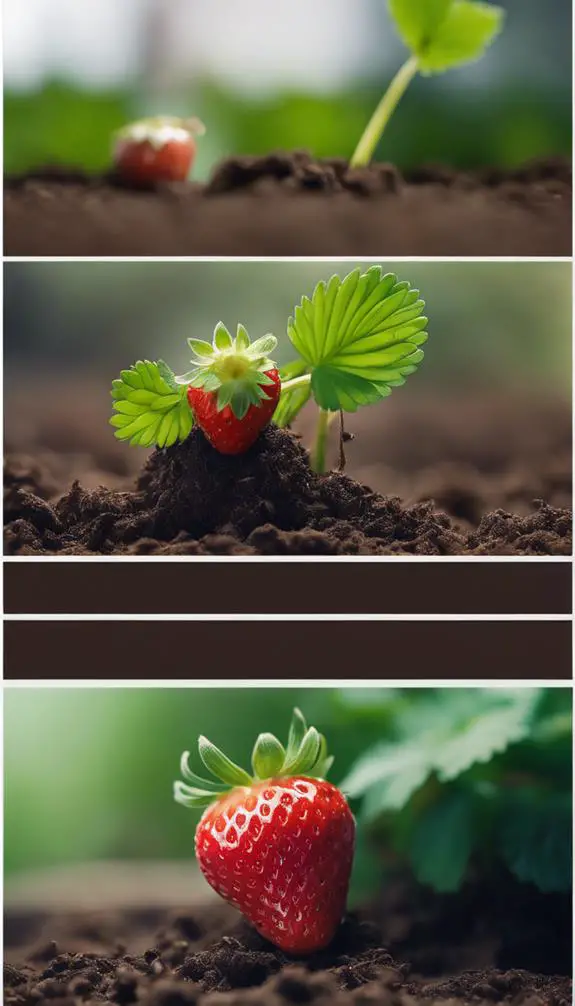You're keen to grow strawberries from seed, but where do you start? It's not as simple as tossing some seeds in the soil and waiting for a bounty of juicy fruit. To increase your chances of success, you'll need to prepare your seeds, choose the right growing medium, and provide ideal conditions for germination. With the right techniques, you can coax those tiny seeds into thriving plants. But what's the best way to treat your seeds before sowing, and how can you guarantee they get the right amount of light and water? Let's take a closer look at the steps you can take to grow delicious strawberries from seed.
Summary
- Treat strawberry seeds with a fungicide and store them in an airtight container at 40°F for 30-60 days to break seed dormancy.
- Plant seeds 1/8 inch deep in a growing medium with a pH between 5.5 and 6.5, and gently firm the soil for good contact.
- Maintain a consistent temperature of around 70°F and provide indirect light, keeping the soil covered with a clear plastic bag or cloche.
- Check soil moisture levels daily, aiming for a consistent level similar to a damp sponge, and provide at least six hours of direct sunlight.
- Transplant seedlings into larger containers with a well-draining potting mix, verifying soil temperature is between 60°F to 70°F for ideal root growth.
Prepare Strawberry Seeds for Sowing
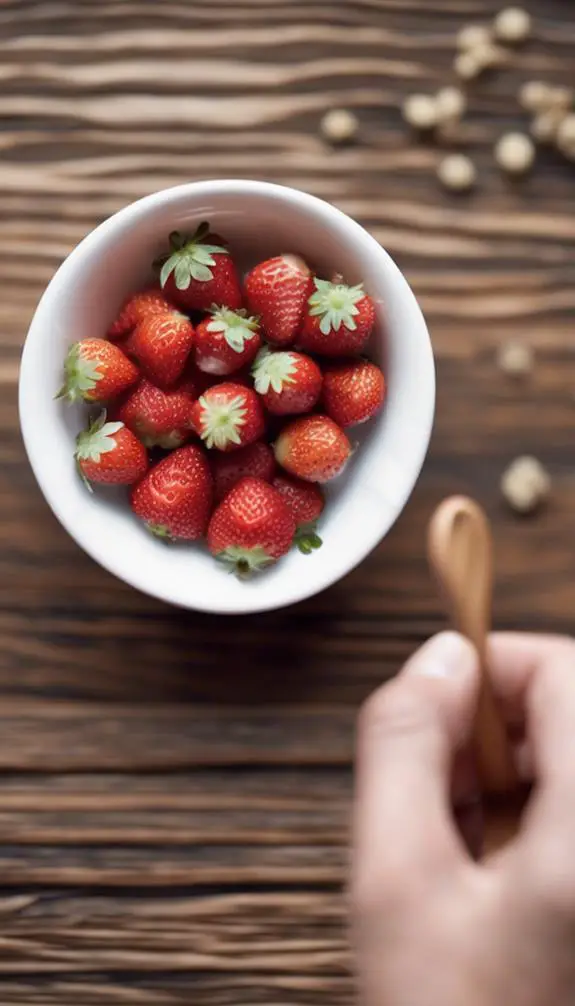
To kick-start your strawberry growing journey, you'll need to prepare the seeds for sowing.
Begin by treating the seeds with a fungicide to prevent fungal growth and disease. This seed treatment will increase the chances of successful germination.
Next, store the treated seeds in an airtight container in a cool, dry place (around 40°F) for 30-60 days.
This period of cold stratification will break seed dormancy, ensuring uniform germination.
Proper seed storage is vital, as strawberries have a short viability period.
Store the seeds in a paper envelope or a breathable material, avoiding plastic bags or airtight containers that can trap moisture.
Choose a Suitable Growing Medium
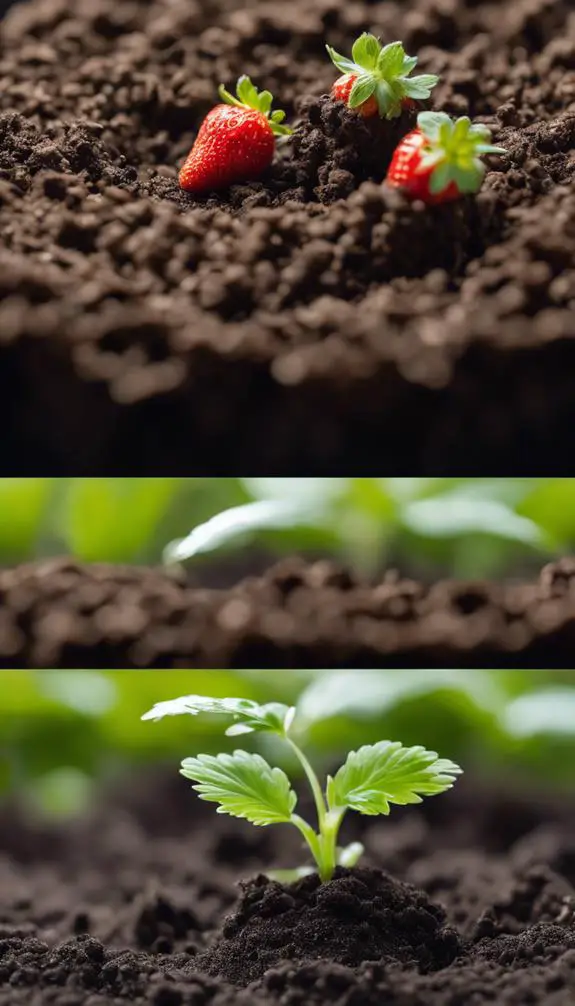
Having prepared your strawberry seeds, you're now ready to focus on providing them with a suitable growing medium.
When selecting a growing medium, consider the soil composition. Strawberry seeds thrive in well-draining, loose soil with a pH between 5.5 and 6.5.
You can opt for a general-purpose potting mix or create your own mix using a combination of peat moss, vermiculite, and perlite. Aim for a mix that retains moisture but drains excess water to prevent root rot.
Avoid using garden soil from your outdoor garden, as it may contain pests, diseases, or weed seeds that can hinder strawberry seed germination. Instead, choose a high-quality potting mix specifically designed for seed starting.
Sow Seeds at the Right Depth
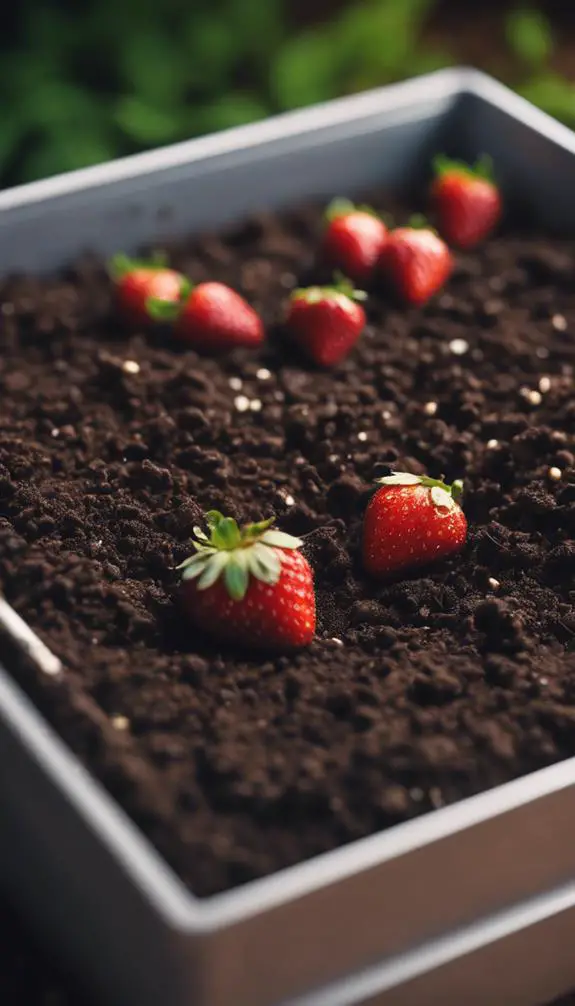
Plant your strawberry seeds about 1/8 inch deep in the growing medium, gently firming the soil around them to guarantee good contact.
This seed depth allows for superior germination, as it provides enough moisture and light while preventing washing away.
Certify the soil preparation is thorough, with a well-draining mix that's specifically designed for strawberries.
Avoid sowing seeds too deeply, as this can lead to poor germination rates.
Instead, focus on creating a stable environment that fosters healthy seedling growth.
Provide Ideal Germination Conditions
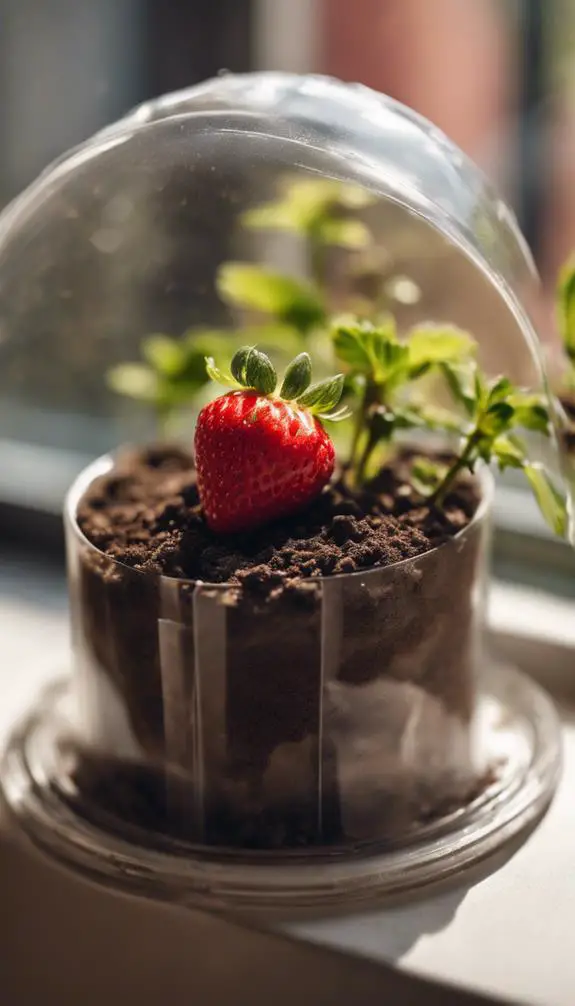
With your seeds sown at the ideal depth, you're ready to create an environment that fosters successful germination.
To achieve this, guarantee the soil is sterilized to eliminate any fungal or bacterial pathogens that may hinder germination. You can sterilize the soil by heating it in the oven at 300°F (150°C) for 30 minutes.
Additionally, consider seed scarification, a process that involves scratching or nicking the seed coat to facilitate water uptake and germination.
Maintain a consistent temperature of around 70°F (21°C) and provide indirect light. Keep the soil covered with a clear plastic bag or cloche to maintain humidity and promote germination.
Maintain Soil Moisture Levels

Get ready to water your strawberry seeds by checking the soil moisture levels daily.
You can use soil sensors to accurately monitor the moisture levels, ensuring you're not overwatering or underwatering your seeds. Mulching benefits also come into play here, as it helps retain soil moisture and regulate temperature.
Aim to maintain a consistent moisture level, similar to a damp sponge. Water your seeds when the top inch of soil feels dry to the touch. Avoid getting waterlogged, as this can lead to root rot and poor germination.
Offer Sufficient Light Exposure

Most strawberry varieties require at least six hours of direct sunlight per day to produce a bountiful harvest.
You'll want to verify your seedlings receive sufficient light exposure to promote healthy growth and development. Aim for south-facing windows or use grow lights that mimic the natural light spectrum.
Strawberries thrive under a balanced light spectrum with a mix of blue, red, and green wavelengths. Providing the right amount of sunlight hours will stimulate photosynthesis, leading to stronger roots, leaf growth, and eventually, fruit production.
As you're growing strawberries from seed, crucially, you must monitor and adjust the light exposure accordingly to meet the changing needs of your plants.
Monitor for Seedling Emergence

During the 7- to 14-day germination period, keep a close eye on your seed trays or pots for signs of seedling emergence.
You'll want to exercise seedling vigilance, as timely detection is vital for peak growth. Check your seeds daily, looking for tiny white roots and green shoots breaking through the soil surface.
Germination timing is critical, so be prepared to respond promptly to emerging seedlings. Maintain the soil remains consistently moist but not waterlogged, as this can hinder seedling growth.
As seedlings emerge, you'll notice their delicate stems and leaves. Monitor their progress closely, taking note of any signs of stress or disease. Your attention to detail will pay off with healthy, thriving strawberry plants.
Thin Seedlings to Ideal Spacing

Your strawberry seedlings have emerged, and it's time to thin them out to ideal spacing.
This vital step guarantees healthy growth and prevents overcrowding, which can lead to disease and reduced yields. Check the seedling density by counting the number of seedlings per square inch.
Aim for 1-2 seedlings per square inch for peak growth. Use thinning techniques like gently pulling or cutting the weaker seedlings at soil level.
This selective process allows the strongest seedlings to dominate, promoting robust growth and fruit production. Proper spacing also enables better air circulation, reducing the risk of fungal diseases.
Fertilize Strawberry Seedlings

You'll want to guarantee your strawberry seedlings receive a balanced diet of soil nutrients to promote healthy growth and fruit production.
To achieve this, you'll need to strike the right balance between nitrogen, phosphorus, and potassium, which will vary depending on your soil type and the seedlings' growth stage.
Soil Nutrient Balance
Strawberry seedlings thrive in a well-balanced soil environment, where essential nutrients are readily available.
You'll want to guarantee your soil pH is between 5.5 and 6.5, as strawberries prefer a slightly acidic to neutral soil environment.
Nutrient cycling is also vital, as it allows nutrients to be released and reused by your seedlings.
You can achieve this by incorporating organic matter like compost or well-rotted manure into your soil.
This will provide a slow release of nutrients, promoting healthy growth and development.
Monitor your soil's nutrient levels regularly, and adjust as necessary to maintain a balanced environment.
Proper Feeding Schedule
During the initial stages of growth, fertilizing strawberry seedlings at regular intervals is crucial to promote healthy development and maximize fruit production.
You'll want to provide your seedlings with a balanced fertilizer that meets their unique strawberry nutrition needs. Start by fertilizing your seedlings once a month with a water-soluble fertilizer at half the recommended strength.
As your plants grow, you can gradually increase the fertilizer timing and strength. A balanced fertilizer with a ratio of 10-10-10 (nitrogen-phosphorus-potassium) will provide your seedlings with the necessary nutrients for ideal growth.
Transplant to Larger Containers
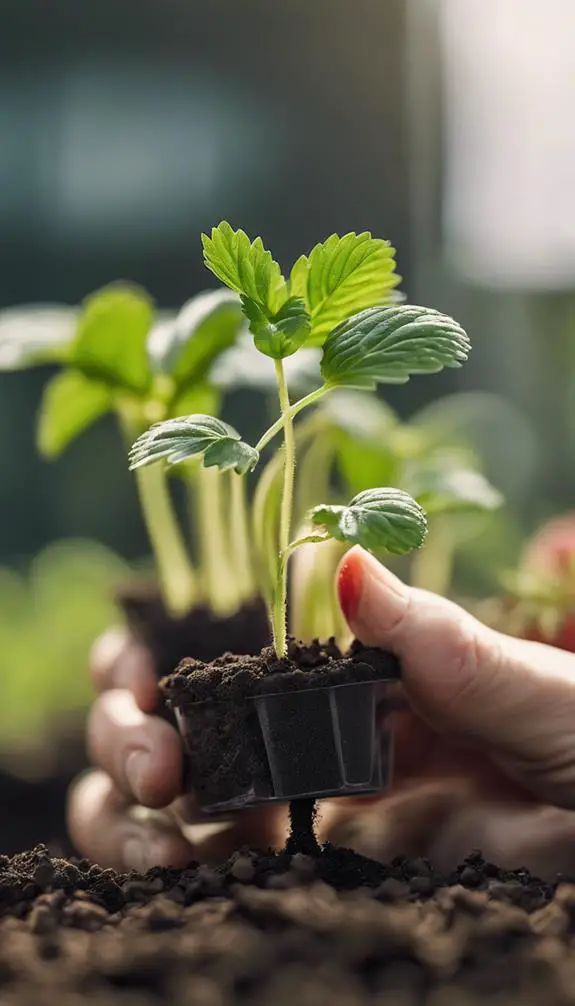
A sturdy transplanting process is essential for your strawberry seedlings' healthy development.
You'll know it's time to transplant when the seedlings have two sets of leaves. Prepare larger containers with a minimum size of 6-8 inches deep and 8-12 inches wide.
Use a well-draining potting mix with a pH between 5.5 and 6.5. Soil temperature is pivotal, so verify it's between 60°F to 70°F (15°C to 21°C) for ideal root growth.
Gently remove the seedlings from their cells, taking care not to disturb the roots. Place them in the new containers, firming the soil around the roots.
Water thoroughly, and keep the soil consistently moist during the first week after transplanting.
Watch for Pests and Diseases

Vigilance is key in identifying potential threats to your strawberry plants' health.
Regularly inspect your plants for signs of pests or diseases, paying attention to any unusual markings, discoloration, or changes in growth patterns.
For pest identification, look for tiny eggs, larvae, or actual pests like aphids, whiteflies, or spider mites on the leaves or stems.
Disease prevention is vital, as fungal diseases like powdery mildew or botrytis can quickly spread.
Check for symptoms like powdery residue, black spots, or grey mold.
Remove infected plants or treat them with organic fungicides to prevent the disease from spreading.
Keep your plants well-watered, but avoid overwatering, which can exacerbate disease issues.
Train Strawberry Runners Properly
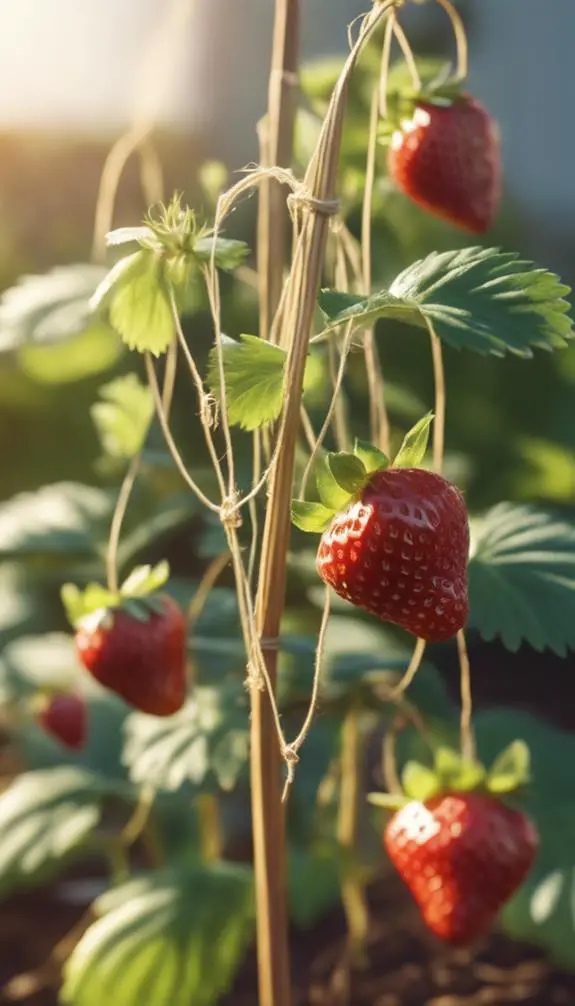
You'll want to select runners with at least three sets of leaves and a small crown, as these have the highest chance of producing fruit.
Once you've chosen your runners, prune them to encourage ideal growth by trimming back the flower stalks and removing any weak or spindly growth. By doing so, you'll direct the plant's energy towards producing healthy, fruit-bearing runners.
Runner Selection Criteria
The strawberry plant's reproductive strategy relies heavily on runners, which are long stems that produce new plants at their tips.
When selecting runners for propagation, you'll want to choose those with desirable traits. Look for runners from high-quality strawberry varieties that exhibit robust growth, disease resistance, and high yields.
Assess the runner quality by examining its length, thickness, and color. Opt for runners with a minimum of three leaf nodes, as these will produce stronger plants. Avoid runners that are weak, spindly, or show signs of disease.
Pruning for Optimal Growth
How do you coax the most out of your strawberry runners? Pruning is key.
Train your runners to encourage fruitful stems and promote healthy strawberry crowns. Start by identifying the mother plant, then gently twist and bend the runner to create a "T" shape. Secure it with a U-pin or a rock to keep it in place.
This technique, called "pegging," allows the runner to take root and produce a new crown. Remove any weak or spindly growth to direct the plant's energy towards fruiting.
Prune back the mother plant's flower stalks to channel energy into producing more runners. By pruning strategically, you'll maximize your strawberry yield and create a thriving, productive patch.
Enjoy Your Harvested Strawberries

Freshly picked strawberries overflowing from your basket are a sweet reward for your hard work in the garden.
You've successfully grown strawberries from seed, and now it's time to enjoy the fruits of your labor!
After harvesting, gently rinse the strawberries with cold water to remove any dirt or debris.
For fresh storage, pat the berries dry with a clean towel and store them in a sealed container in the refrigerator.
You can also freeze or dehydrate strawberries for later use in various recipes.
Try incorporating your fresh strawberries into innovative recipes like strawberry basil salads, strawberry-balsamic vinaigrette, or strawberry-infused water.
Experiment with different preparation methods to release the full flavor and nutritional potential of your homegrown strawberries.
FAQs
How Long Does It Take for Strawberry Seeds to Germinate?
When you sow strawberry seeds, you're waiting for germination, which typically takes 1-3 weeks, depending on seed viability and climate factors like temperature, humidity, and light exposure, which you'll need to optimize for successful sprouting.
Can I Grow Strawberries in Indoor Pots Year-Round?
You can successfully grow strawberries in indoor pots year-round by mimicking outdoor conditions, maintaining a consistent indoor climate, and providing supplemental lighting, allowing you to enjoy a winter harvest and continuous production.
Will Strawberry Seeds Produce Fruit in the First Year?
You'll likely wait until the second year for strawberries to produce fruit, as seed viability affects fruit expectation; it's rare for seeds to germinate and mature enough to yield berries within the first 12 months.
Can I Use Strawberry Seeds From Store-Bought Strawberries?
You can try using seeds from store-bought strawberries, but be aware that their viability and freshness are uncertain, potentially affecting germination rates and plant quality, so crucial to test their viability before sowing.
Do Strawberry Plants Require Support as They Grow?
As you nurture your strawberry plants, you'll notice they'll need support to thrive; consider using strawberry stakes or trellis systems to keep them upright and promote even fruiting, ensuring a bountiful harvest and maximizing your yields.
Conclusion
You've successfully grown strawberries from seed! Now, enjoy the fruits of your labor. Harvest your strawberries when they're bright red and sweet. Regularly pick them to encourage continuous production. With proper care, your strawberry plants will produce multiple harvests. Continue to maintain ideal growing conditions, and you'll be enjoying fresh, delicious strawberries for months to come.


